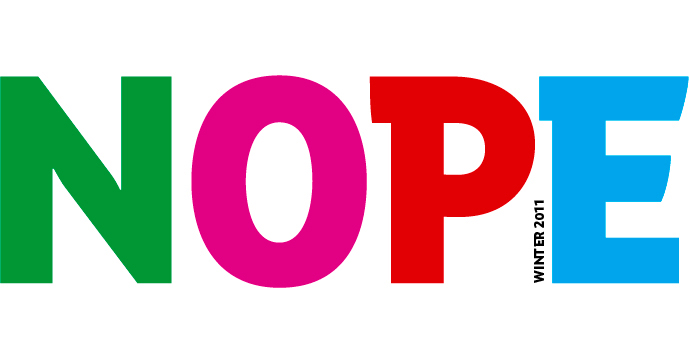
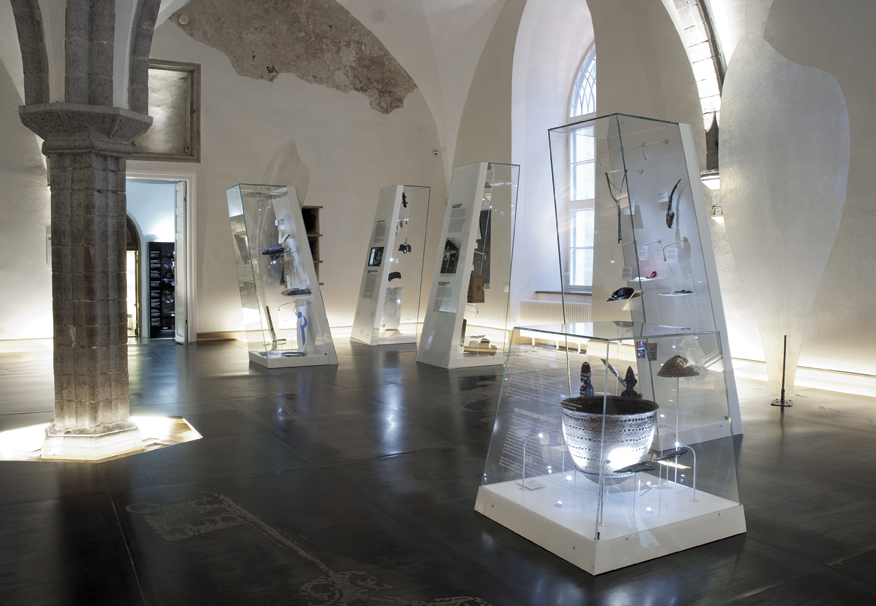
Photo: Karel Koplimets

Photo: Karel Koplimets
In the Old Town section of Tallinn in the Suurgildi building the Estonian History Museum interior design is the result of the combined effort of more than ten EAA graduate students. The finding of a proper balance between two values, keeping the historical ambience and the historical displays was in her view one of the greatest challenges for the chief architect Liis Lindvere.
According to the builders the Lindvere plan exiting. Along with the former KOKO architechture bureau interior architect Margit Argus and Margit Aul an attempt was made to create an atmosphere which could not be found anywhere else. The chief architect working at KOKOs Lindvere stated that the work was exiting but complex. “One had to deal with many small details and relate to a number of curators.”
It was necessary to reconcile and unite the views of history of ten people – bicycle, time capsule, metal floor, horses, dragons and much more. All these items take on importance when seen in the “pearl” of the Old Town the Suurgidi building.
The history interior design project was directed to KOKO, so that there was not a competition which Lindvere had to take part in. All the more reason why they felt a greater responsibility. “The expectations from the History Museum were great as they wished to a modern contemporary exposition, while at the same time one had to keep in mind that they were dealing with the Suurgildi building.” stated Lindvere, but how many people actually get to hold the very special exhibits in their own hands? “We were able to see in the archives a range of items while wearing white gloves and handle rare pistols “ stated Lindvere. Good projects are those which offer the chance to overcome challenges and provide exiting experiences.
To be satisfied with your own ideas and application of them and provide the History Museum people with what they want a theme of northern countries runs through it. This meant a white background colour and iceberg resembling display cases. “This was contrasted with black and grey metal which was to symbolize this dark country.”
The Museum floor is worthwhile seeing itself. The Main Hall of the Museum covers 270 square meters. “We engraved various pictures in metal with acid,” stated one of the creators of the floor, an EAA jewelry and blacksmith’s workshop leader Risto Tali. The floor was made working with smith Rait Siska. The floor in addition to the graphic pictures also shows dragon footprints which lead to the various exhibitions, for example to vigri and silver coins. “It was truly an exiting project where we spent two to three months steaming metal with sulphuric acid.” stated Tali.
The courtyard of the Museum there is a meter size globe which turns on ballbearings. The globe weighs 300 kilograms and has engraved on it a map of present day Estonia. And not only in the Main Hall thought has been given to the specifics. For example the Museum foyer visitors will find a desk which contains part natural and grains painted black . “These symbolize the changing population numbers during various eras. Dates are shown and for every 500 people there is one black grain which allows you to see how the population of Estonians has expanded and contracted over time, ” explained Lindvere.
However the work done by the EAA graduates does not end with this. Metal artist Tõnu Narro has made a small version of a bicycle found in Estonia which can be ridden by children. Bruno Lillemets and Argo Männik made a rocking horse out of wood. In addition to this a dragon which supposedly made the footprint tracks on the floor. Lillemets and ja Männik have constructed a three and half meter metal and fiberglass “wings” which resemble feathers. The purpose of this is to enable texts to be attached to them and be hanging in the air.
“Spacially the exhibits have to appear to be almost invisible in the Great Hall,” explained Lindvere,” she gave as the reason why texts had to be placed on the wings and the cupboards and shelves made invisible by explaining that this allows the visible to be made visible with the help of the invisible. “The theme was entirely new in every respect and every detail and material use very location and theme specific but exiting at the same time,” stated Lindvere.
When the feeling arises that you need a second opinion on your creation then Portfolio Café «speed-dating» is just the place. Just what Portfolio Café is and how it helps primarily young creative people that is what Anneli Porri EAA Fine Arts Depratment Docent and the Portfolio Cafe originatior will explain.
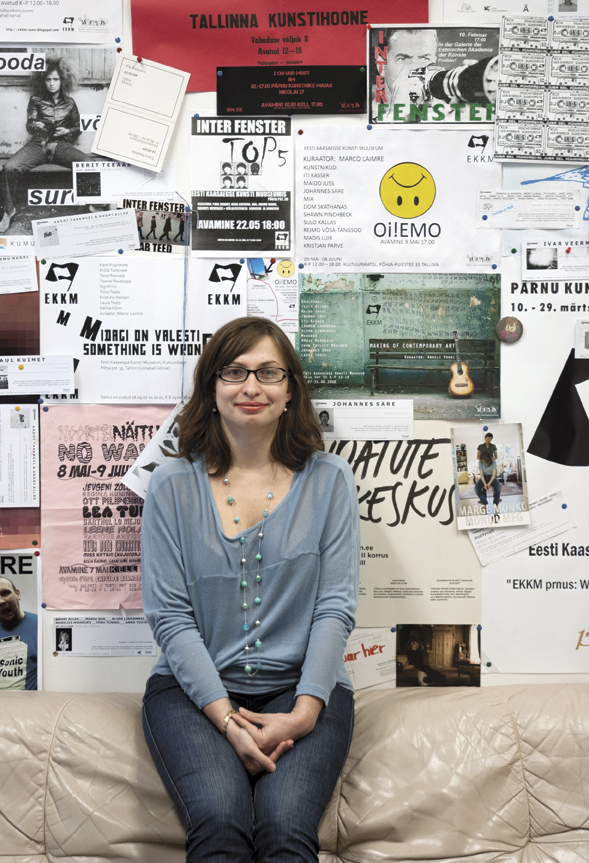
Photo: Karel Koplimets
What is a Portfolio Café ?
A portfolio cafe is in the art world a prevalently adopted way to bring together artists and art experts. We use such a so called speed-dating model method: where an artist meets alone for about twenty minutes with an expert during which time the the presenter introduces him/herself and the creation and the expert is able to get answers to his questions. The expert is then expected to make suggestions and share contacts and etc. After one conversation the presenter moves on to the next expert.
So that self introduction becomes habitual to the student?
Yes to introduce yourself seven times seems at first to be quite bothersome but each introduction is different as it is specifically directed to the professional, who is shown the creation.
Who needs a Portfolio Cafe and why?
It is needed for young artists so that they will have yet another form for making professional contacts with the art world. This way the student gets feedback from someone other than their teacher an evaluation which is impartial and perhaps more direct and forthright. The student practices presentation, develops contacts, gets advice and criticism, introduces the creation and finally gets an invitation to work together. The expert gets a more comprehensive overview of the art field and hopefully finds an artist to work with in the future.
When did the last Portfolio Café take place and how many paprticipants were there?
It took place during the Design Night in September 2011. There were seven experts and sixteen young artists and some more experienced designers showed up to have their creations evaluated.
Who are the experts and how are they selected ?
On inviting the experts two conditions are essential: first they should have a showing or preparation for some event under way such as a gallery of residenture program preparation at the time. This is because this would show that they have motivation for meeting with the art students and become aquainted with their portfolios. A second criterium is their ability and readiness to give feedback. Thus far there has been good cooperation with galleries and residentures with curators in Helsinki and Riga with freelance curators, art journalists and art show organizers as well with artists.
Who is Portfolio Café for?
Generally speaking the portfolio meeting is most beneficial for young artists, Masters Degree students or graduates. Bachelor level students have generally not been able to create portfolios or sufficient number of finished creations to how and to have them evaluated in the dialogues and this would leave the experts with little to work with.
When will the next Portfolio Cafe take place and who is expected to attend?
Hopefully we will conduct the next Portfolio Cafe during the EAA Urbanistics Days in the Spring of 2012. What exactly the nature of the event will be is yet to be determined.
STUDENTS TECHNICAL SOLUTIONS
EAA product design students created an electric heating oil which has two main attractive characteristics, it is reliable and extremely economic.
Arofer OÜ coil project manager Siim Nellis stated, that the practicality and engineering technical solutions were the main worries which arose when first cooperation with EAA was considered. „My concern was that perhaps there were students at EAA who were too artistic who might not be able to solve technical problems“ he stated. But the worry disappeared when Nellis saw the first student created plans „I was truly surprised to see the EAA students propose such a high level solution to the engineering technical problems.”
The first drawings and prototypes are now ready. When exactly it is time for production and marketing of the electric coils Nellis was not prepared to say at this time.
At first Nellis sought partners from elsewhere at Tallinn Technical Univeristy and Tartu University but for various reasons cooperation did not result with the two prestigious Univeristies.
EAA was reached by him through the Enterprise Estonia which has a list of partners on its web site indicating which organizations are available for joint work and cooperation in innovative projects.
Nellis praised work with EAA. „I had an opportunity to relate to everyone directly and even take part in classes,” he stated and added that this type of cooperation speeded up the work process. The results were exactly what Nellis had imagined and expected. He praised the product design department head Heikki Zoova for the cooperation who emphasized that most important is to keep in mind what the client wants.
Also Nellis liked the fact that Zoova included in the people who were familiar with putting coils together and were thus able to share valuable experiences. „With coils specific engineering solutions are important and Heikki Zoova brought along to the project the right specialists who had valuable product development experience” stated Nellis.
EAA students were given the task of developing the coil body and the design solution. The students offered very attractive designs but some were not ideas which could be produced. The best solutions had to be chosen as coils could be made attractive but still would not sell as there is no market for them.
The final result was that both the students and Nellis were very pleased. „The coils have a an attractive appearance and is very economic. He recommends working with EAA students in the future.
New design solutions, new products and new old historical Linda brand – all those words describe the Lindante OÜ fur coat and gloves collection which has been created by the EAA Fashion Design and Leather Art Department students.

Photo: Karel Koplimets
«Lindante projects magic comes from the making the style new using the Saga technology » stated a designer Fashion Design MA student Joanna Kivihall and added that Design students concepts and become realized as product is a true bonus. The Fur creation is given a Saga Design Center prepared hand made, creative and innovative appearance and image.
At the beginning of the project Lindante OÜ ordered from EAA students a range of collection concepts from which the entrepreneur was later able to choose those which were most suitable for them. Three departments, Fashion, Leather Art and Graphics Design, worked on the design of the products. The production process has begun where new fur coats and gloves are made out of lambs skin and Estonian own wild animal skins.
To the question if such an order by a business undertaking does not interfere with the work of the creativity of the artists Kivihall stated that at first the designers were given complete freedom in the project so that the creative flight of ideas was not interfered with. «Later we became more specific, so that cooperation with the entrepreneur made products more acceptable to both » stated the Fashion Designer and added that this left less room for art but that is inevitable in design work field. «You have to consider the wishes of client and the needs of the business,» stated Kivihall. Yet the design solution has to be such that it is attractive, has something which differentiates the product from others and creates interest!
Leather Art Department Head Lennart Mänd praised the project which gave the students an opportunity to gain new experiences which are definitely useful for them after graduation to do better in life. «And definitely it was exiting to deal with real problems,» he stated adding that such an assignments force dealing with real concerns and places things in prespective.
The cooperation between Lindante and EAA has now taken place for several years but such an approach where design solutions are ordered from EAA students, was a first. «EAA students have for years been placed at Lindante so now we decided to try cooperation on a new level,» stated Lindante Manager Tarmo Kattago.
That it was possible to cooperate in this way became known to Kattago through an seminar which took place in the Spring where EAS innovation program involvement working with EAA was introduced.
To the question if the colletion is good and ready for the next Winter Kattago stated that they hope to finish the collection by January 2012. The finishing phase of the project involves the creation of a catalogue with stylized photos. «The project is half way finished but on the basis of the results thus far it is possible to state that using EAA talent and competence has fully justified itself,» stated Kattago.
Pavel Sidorenko is a 31 year old designer, who even when he was studying at EAA was always interested in competitions to be able to deal more with his specialty. Even today at the product design bureau at KEHA 3 Siderenko maintains that the secret to success is that you have to be a fanatic in your own area.

Photo: Karel Koplimets
In our market economy it is customary for gradutes to come togetehr after ten years and discuss who has now exactly done what. Do you thnik that you have done well after graduation? Have you accomplished what you set out to do?
That is difficult to say, but I think that more or less yes. One can always do better but at the moment I am satisfied with what I have accomplished. At the same time I do not yet consider myself to be a successful designer.
What is missing?
Nothing is specifically missing but one has to keep on studying and improving oneself.
You improved yourself regularly during your school years and participated in many competitions.
Yes I did. Some I participated in through EAA, some I sought through the internet by myself. My view is whether money is involved or not one should always particapate interesting competitions.
Why?
It isimportant for students and others because each competition add to knowledge and open up horizons. Also young students are very enthusiastic and see design solutions which have been dated in a new light and through this can renew and created new and fresh solutions.
How many competitions have you taken part in and do you think that it has been enough?
I have taken part in about ten competitions and that was enough. You can always take part in more but there is not enough time. As a student I liked Martin Pärn created solutions in the Design department. This allowed me to make use of them in the competitions. Taking this approach it is possible for students to take part in more competitions.
To approach matter more philosophically what is the key to success?
In my view the worker has to be fanatic in his area. One has to do the work with heart and dedication.
And you are a fanatic?
Yes, completely, you have to be a workaholic (laughing) editor.
Is it hard to make it in the Design marketplace do you have to struggle a lot?
The answer depends on who is called a designer and there has been considerable debate about this issue. The word designer is simply a convenient word so that many people want to use it. Even those who who are really not designers. When a person in manufacturing makes something and calls it a design product he then feels that it has gained more in value. But to speak about product design there is a lot of work involved down to the smallest details. Unfortunately there are a lot of people who do not see the value of designers and why they are needed at all.
So that in Estonia to be a designer is somewhat complicated?
If that... but the internet has developed to the extent that many relate through it. For example if there are people outside Estonia who want to employ our designers, then please let us know.
How in your opinion have the last years of economic downturn changed the life of designers?
The market is flooded because every year more graduates enter the market and there is not enough work for them. On the one hand the last crisis years have been difficult for students because it has been difficualt to find work. On the other hand it has been good because the crisis cleared the market. We will have to see what the future brings. My view is that the capitalistic system which we live in has been structured in a wrong way. We hold wrong values- lack honesty where large enterprises manipulate people and try to market products at high prices which are not really as valuable.
Aside from Keha 3 you design a range of products, we know for example of vinyl clocks and other things. Where do you see yourself working in the future, as an entrepreneur or employed by someone?
I have always though that I would be doing my own thing and own my own design enterprise. At the same time I wish that I had my own house which has a studio with large windows.
In every country with maritime interests there has to be a shipbuilding pool and Estonia can soon consider itself to be a full fledged maritime nation. This is because of the TTU Kuressaare College in cooperation are involved. The plans for the building have been completed and the shipbuilders are now waiting for the much needed pool which will add a new exiting element to the Kuressaare city center.
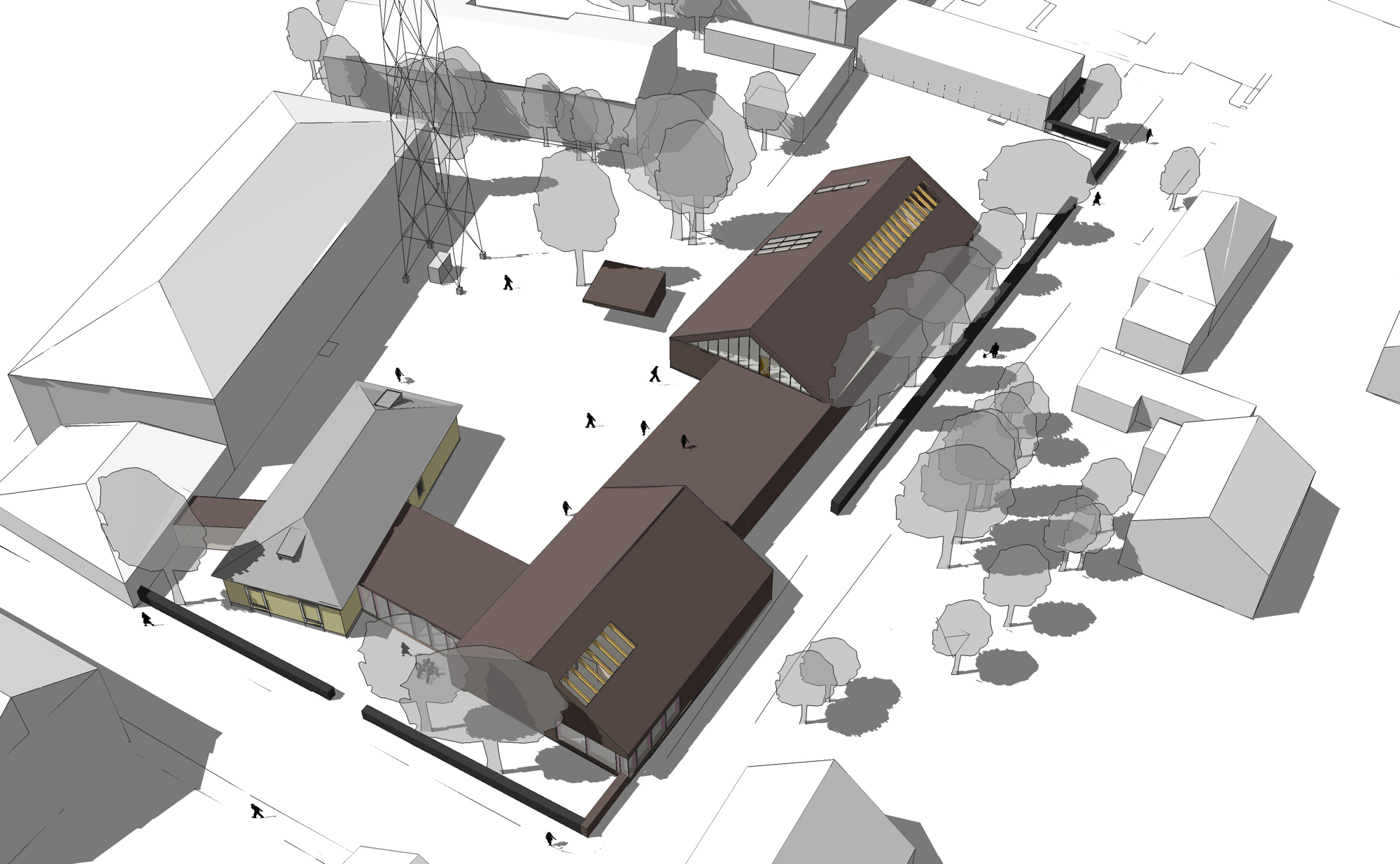
Drawing: Mari Hunt, Aet Ader ja Kadri Klementi.
Kuressaare small shipbuilding testing pool and laboratories building was prepared by in cooperation with Kalle Komissarov and Lembit-Kaur Stöör. This type of pool is new to Estonia and in the Baltic countries. In addition to students the facility will be used by shipbuilding enterprises.
To describe the project the architects say that they were inspired by the limitations. The historic setting and not frequently found function. «The site located beside the main street with existing buildings located in the Old Town of Kuressaare and to build there a 60 meter pool was a real challenge!» recalls Hunt and adds that the length of the pool was a serious factor in this project. «When the pool was drawn on the site there seemed to be little room left over for anything else.»
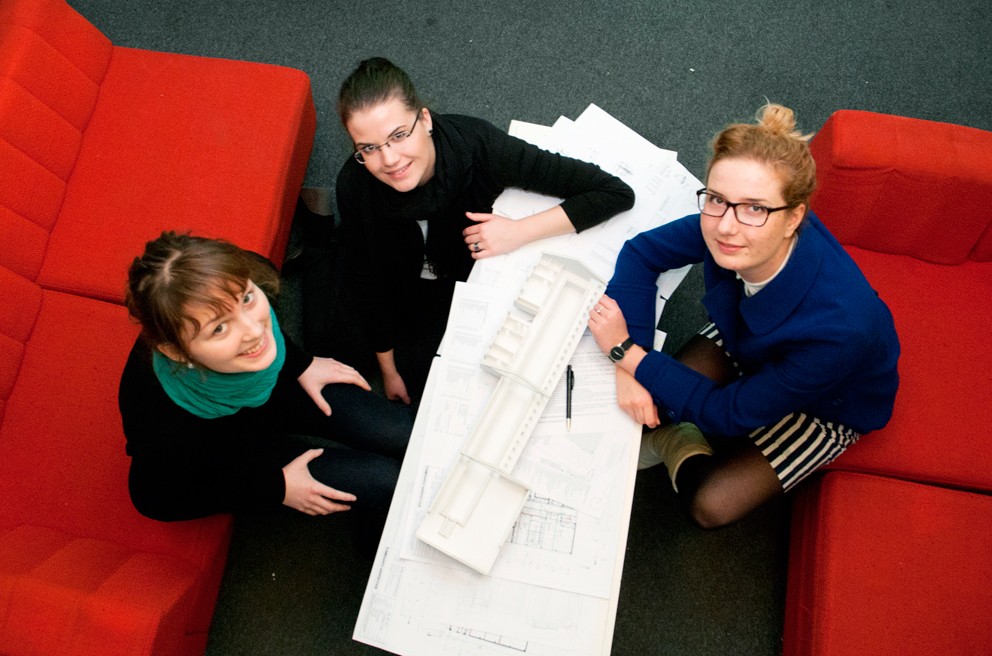
Photo: Karel Koplimets
Also it was necessary to make the building fit in with the historical setting and to become familiar with the requirements of an unknown area of expertise. «It was very exiting to become acquainted with the the area of shipbuilding which was new to us: how models are used to test, what technology is used and measuring devices are used,» added Klement.
This is why such a laboratorium project required not only close cooperation with the builders but also contact with the scientists who will be using the building.
Kuressaare College small shipbukollelding curriculum project manger Jaanis Prii and small shipbuilding competcnce centre head Anni Hartikainen stated that the were pleased with the cooperton between EKA graduates and the pool project leaders. «The timeschedule was tight and since the pool will be located in the the centre of the city it was necessay to take into account the specific location related conditions and future challanges,» stated Prii and added that a somewhat complicated project for the region was suitably dealt with and problem solved.
The architects handled well the specifics of the pool building. «For example it was very important to consider the transportation and where the ships were made ready for it by thinking the problem through thoroughly beforehand,» stated Prii and added that this required serious concentration by the architects.
The pool is essential to shipbulding enterprises who at this time ask Swedish and Finnish scientists to do the work for them and this makes production development in scientific circles in Estonia considerably more expensive. Estonia having its own pool which is specifically designed for small shipbuilding makes this an optimal solution for keeping down expenses.
The new pool enables the teaching of small shipbuilding at a much higher level of education which will ensure that we prepare have another generation of qualified shipbulders for the future,» stated Prii and added that every maritime nation needs tohave its own testing pool.
EAA product design department Master student Lauri Hirvesaar designed three wheeled friend seems at first glance to be just an ordinary scooter but no – we are dealing here with a unique product which can in the future make the work of postmen or delivery persons much easier.
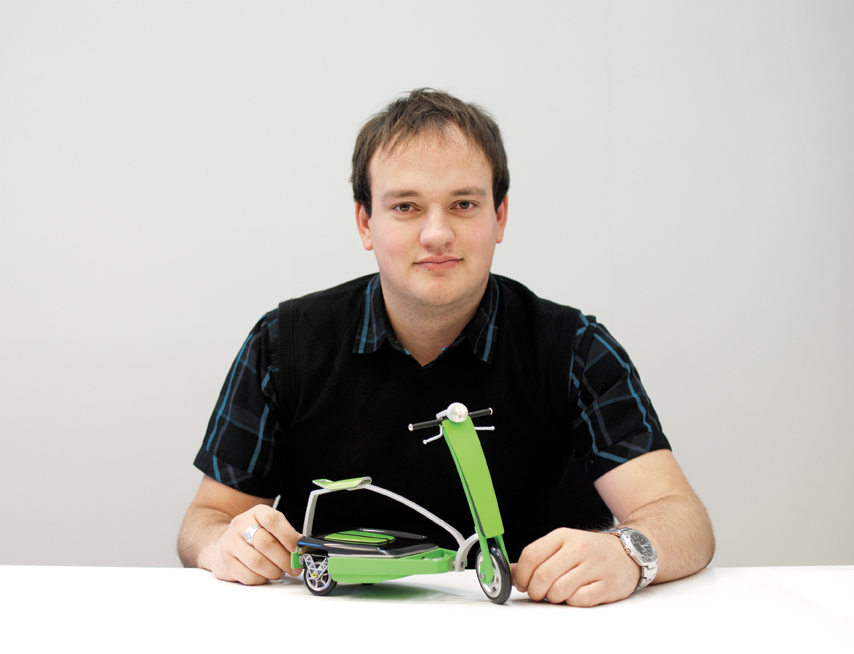
Photo: Karel Koplimets
«Most inspiring were chance happenings, thoughts of some small detail which would come before going to sleep and make you wait hopefully for the next work day,» stated the 25 year old designer Lauri Hirvesaar, who exhudes great pride in his Masters degree product. This is justified as Hirvesaar’s package scooter has won many prestigious awards. The most important, according to the designer, the recently finished NeuNow Design Festival where the product reached among the nominations of the liveFestiva.
In the workshop of product designer Matti Õunapuu, where Matti was placed to do his Masters practical work there was an electric machine which was in the process of completion, that is where he became acquiainted with scooters, recalls Hirvesaar. Having been inspired there, his present product took shape bit by bit becoming in time a practical vehicle. What makes the vehicle unique the scooter can be changed to suit the needs and circumstances. «If baggage is not being carried the vehicle can be operated easily on two wheels but if needed to carry something it becomes a three wheeler,» explaines Hirvesaar.
To design a vehicle it is not enough to make an attractive and ergonomic scooter but it has to be reliable. «The designing of a vehicle is serious work,» stated Hirvesaar and added that the work is on the one hand constrained by traffic regulations and laws which have to be taken into account in designing a working vehicle which is roadworthy. «On the other hand ergonomic factors have to be considered, which are very importnat for a two wheel vehicle» stated the designer.
It is evident that the scooter has to be safe and has to be comfortable for the driver and easily driven. This is not possible to achieve unless you have good technical knowledge. «But more important than technical knowledge is the ability to take a wide perspective which helps in finding practical solutions,» found Hirvesaar.
At this time the scooter is still a Masters thesis model but the next stage could well be according to Hirvesaar be to ride around the streets in a prototype. «However to do this requires a lager team and means. As a recent design graduate I cannot yet afford to do that» admitted Hirvesaar and added that in addition to the investments there has to be some certainty that the prototype will lead to production of a series.
But where do design ideas come from? «Ideas come mostly from keeping your eyes open and it pays to look where others are not looking. To see details which at first glance seem to be irrelevant,» answered Hirvesaar. After that if is possible to see the larger picture and see where the idea could find practical application. «And everything can be used, even fingering a nut and bolt could someday result in some interesting technical product or shape of a piece of furniture.»
Every creative person markets his products a way which is suitable to them. We asked three successful creative persons how they market art and design - as independent artists, with others on teams or through Galleries.
BREAKING THROUGH BEING ON A TEAM.

Kristiina Tuubel, Taikonaut OÜ Executive Director / CEO Veiko Liis, Taikonaut OÜ Art Director / Designer
«We have dealt with the selling of product design services for six years now and we have chosen teams as the best way to do this. Is it easier to break through in the market being on a team rather than doing it alone? The answer is it all depends on the team members. Through the synergy of many people and pooling of talents and this creates additional value then the answer is “yes”. However if there are simply more differences of opinions them it becomes more expensive for both the team members and the clients.
In product design the product, the production and the design are important and this in itself indicates a team approach. Often projects are short term and require a lot of resources.The best results are achieved through a well working team.
We have tried a range of strategies. One is where there are definite roles for each member – one deals with finding clients and mangement, others with design.We have also tried a variant where everyone does everything where no one sells. The question becomes in taking responsbility.Who is responsible for the final outfome? Sales are successful for teams when each member is accountable for a specific task.
Using teams it is important that all are honest about their abilities and wishes.There are always strong and weak sides. But when each works on his area of competence then the people are happy and productive. On the other hand if demands are made and there lacks competnce then dissatisfaction takes place. Realistic expectations keep the atmosphere whole and healthy,
We deal primarily with the Estonian market, where the client is sensitive to price. The more intermediaries the higher the price to the buyer. This is why we do not have agents working for us. Who could be be an agent? He should be someone who has knowledge of design and even better relationship and experience in the sales world. These people with such an education are rare in Estonia. A person has to educate himself and gain experience. If we were able to find such an agent then we would glandly use his services and pay him well for it.
At this time we are happy that we have clients who find solutions through us to their design problems and they have been able to recommend us. We deal passively with sales. Sales are simply opportunities to speak to the cliens. Successful is the person who develops and dares to change but at the same time remain firmly in his determined path.»
THE ROLE OF AGENTS IN THE SALE OF ART

Krista Mölder, fotokunstnik. Photo: Karel Koplimets
„I have dealt with Photoart for about ten years, working with Galleries has taken place for the past five years. The first picture which was sold in this way was through Gallery Vaal at a group exhibition of photoar, Dislocated in 2006. The showing on a more stable basis began with Gallery ArtDepoo several years later. Now for over a year Gallery Temnikova & Kasela have represented my work.
The role of a Gallery has been to act as a mediator, an embassador. Enabling me to reach where I cannot by myself. The Gallery offers stable representation. Since Estonia is small and the borders of art are not the same and suitable for nature and my work it suits me best when a specific person or organization represents me and introduces my work on a greater range selling it. Relating is work. I have other activities and roles. It is great that Olga Temnikova has the desire to represent a wide range of art. A Gallery is not a store.
The primary benefit coming from being associated with a Gallery is that it provides exposure and publicity on a wider scale. My pictures have been shown at Fairs where I could not go alone. Even the Deutsche Bank’s collection chief advisor Alistair Hicks found my Landmarks at a Berlin Fair where he was represented in the Temnikova & Kasela box. Several months later after relating by the Gallery and a decision by the Bank’s art Council decision they bought my work for their collection.To be in a good art collection is for me as an artist a great pleasure. The finding of a suitable home/place for my art seems to be similar to enterpreneurship. When placing a puppy we want to see it in a home where there is love and caring, it is the same with art.
TO BE A FREE SPIRIT AND SELL ONESELF
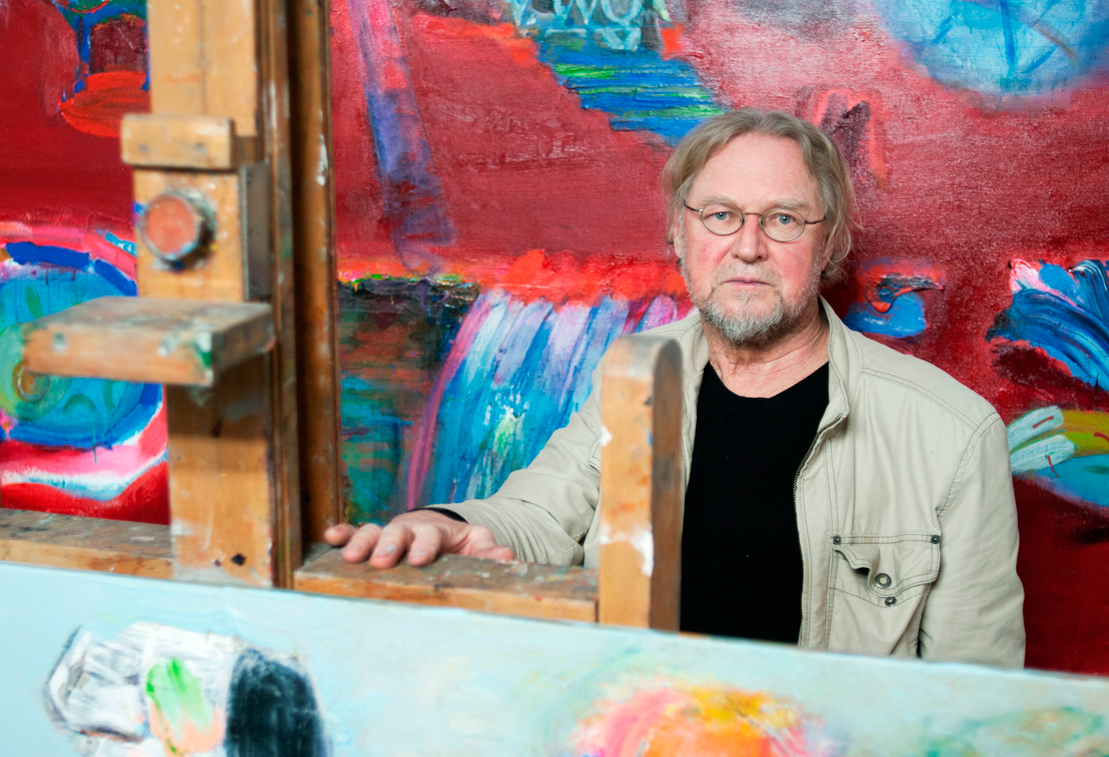
Tiit Pääsuke, EAA tprofessor emeritus, painter in his spare time. Photo: Karel Koplimets
«There are many kinds of painters. There are those who make a living by it – they have studied this and unconciously make concessions to buyers, taking them into account or not . There are others who enjoy their marketing as much as they do the painting, possibly more - they recognize the situation and advertize themselves giving a predictable product. Both sides are satisfied. The quantity of painrings sold in their mark of quality.
My position is idealistic, self centered, old fashioned so the key is this: It is that the painting must sell itself. I do not have to be in the picture.The artist must stand invisible behind the picture not in front of it. Selling does not even come into thought. And when should it take place, as before the painting nothing is known, the painting process provides the pain and pleasure the discovery, losing and experimenting- when would you have time to think about anything else! Commissions where conditions are specified should not be accepted one should not tie oneself with Galleries which expect regular work from you which is easy to sell, this would leave them using me without an income. I know nothing about exhibitions. You have to have the courage to say no.
Ideally one should only sell paintings which have already been shown or ask the buyer of the painting to allow exhibition. Fulfilling all these conditions set by me means that production luckily cannot be large. Sell only when you really need to do so and set your needs accordingly I repeat that this is the position of an old self-centered idealist, which do not please buyers but then I have not always been able to come out of this cleanly. The sale of a painting is like a bonus, you are paid for pleasure. A young artist starting out whose creationis not yet known have strategies today which are different and the life of a freelancer is more difficult..»
Glass artists at EAA made a contribution to the Culture Capital Year 2011. Specifically in cooopertion with Norvegian musicians a completely unique set of musical intruments were created out of glass.

Photo: Kaupo Kikkas
«The idea developed preparing for the Culture Capital Year impromusic program,» stated Tallinn 2011 program coordinator and the Glass world producer Madli-Liis Parts. The wish was to definitely do something with Norvegian musicians Terje Isungset and Arve Henriksen. To create glass instruments was their idea.
Although the artists had free hands in matters of inspiration and creating the ideas in some details the muscicians had their special wishes considered. «For example Terje Isungset had a glass piece of a certain shape and she wished that there were more of them,» stated Parts. But generally the ideas were created during the process- with the artists preparing something and the musicians trying them out, this succeeded sometimes and other times not. «This was not an ordered project in the classical sense but the musicians trusted the artists » stated Parts and added that only artists know the glass as material and its specific characteristics and thus suggest possible technical solutions.
EAA Glass Art Department Docsent Tiina Sarapu stated that the glass instruments project was very attractive for the Cultural Capital and due to her specialty the glass artists had noticed glass musical intruments making the project familiar to them. «In our work we often noticed the odd but interesting sounds the material offered.»
Students of the Glass Arts Department worked on the instruments one session and they were led in this by teacher Eeva Käsper, who herself made several instruments. Many instruments were created during the project, some which are fimiliar such as the xylophone or the equivalent of drums. «Some however were unexpected sounds such as scraping, shuffling, twisting and banging from instruments,» according to Sarapu. This resulted in some thin bent pipe like instruments and others as blocks made of thick glass. A variety of pipes, bells and string instrumetns among other interesting instruments were created.
The musicians Terje Isungset and Arve Henriksen were consulted in the product development pahse «Their creativity was impressive,» Sarapu stated «It was truly great to see how a musicians takes an intrument and finds quickly what sounds can be created which offer a special and soulful sound experience.»
The Culture Capital team with Parts at the head and he EAA glass artists prised the joint work and cooperation. «Since the project was not traditional and artists were faced with the technical world of musicians which they were not familiar with The EAA students can only be praised for joining in and participating in the project,» stated Parts and added that he hopes that many of the artists will continue with this after the Culture Capital Year project is finished.
This means tghat the playing glass instruments could be heard in the in Tallinn Von Krahl theatre just before Christmas this will not end the use of glass instruments in music. It is hoped by both EAA and the managers of the Culture Capital organisers that the instruments will be used in concerts around the world. Also according to Sarapu the instruments are not only unique musical instrumenths but works of art. «Some of the instruments which were heard at the concert in December may find their way to expositions in art galleries,» she stated «Some intruments are both glass musical instruments and glass sculptures at the same time.»
The instruments were made in addition to the previously mentioned Sarapu and Käsper by glass artists Kristiina Uslar, Eve Koha and Eero Vaikre. Students included Andra Jõgis, Mikk Jäger, Külli Nidermann, Caspar Sild ja Maarja Treufeldt.
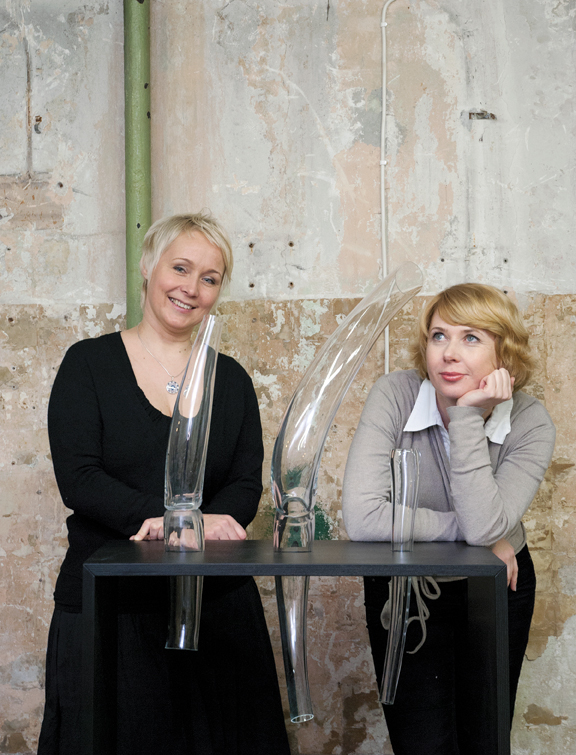
Photo: Karel Koplimets
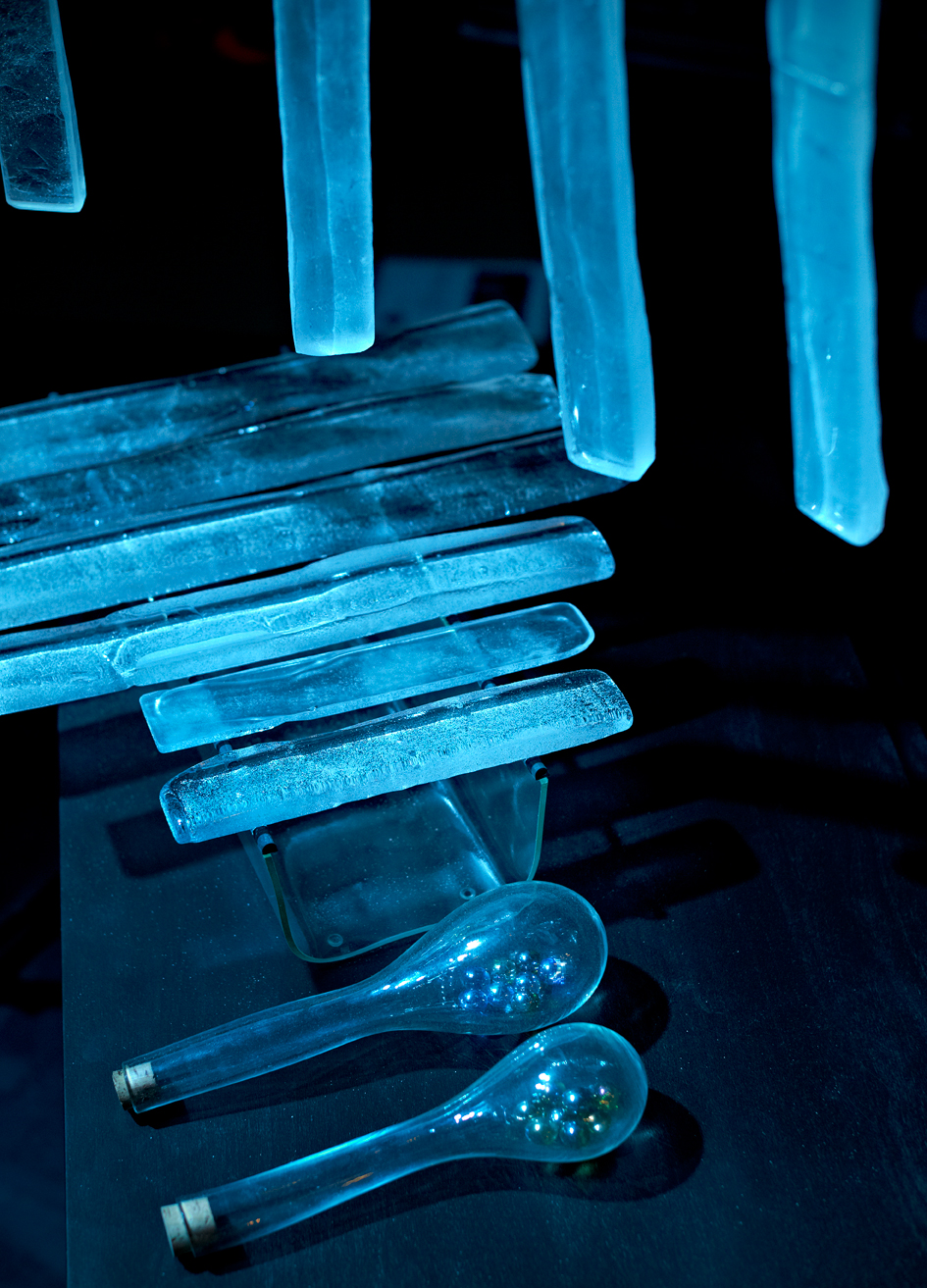
Photo: Kaupo Kikkas
Ingela Heinaste / +372 626 7108 / ingela.heinaste@artun.ee